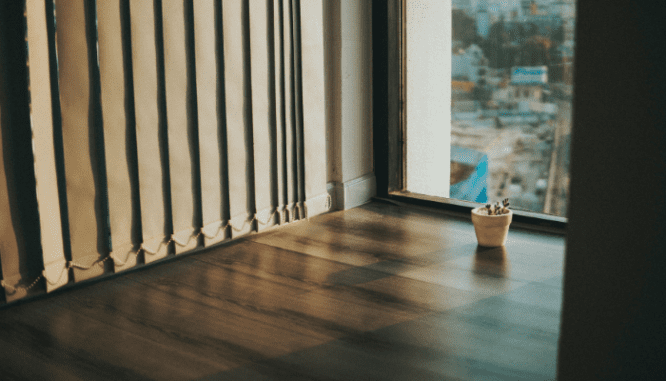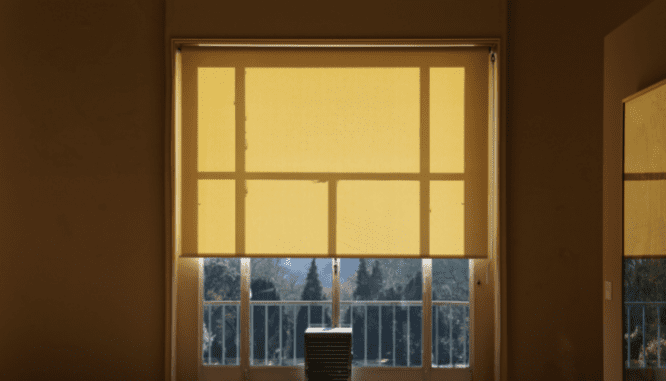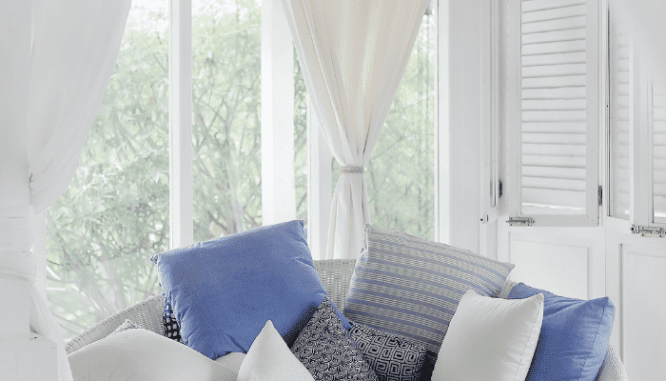Vertical Views: Are These Classic ’80s Blinds Out of Style?
- Published on
- 6 min read
-
 Allaire Conte Contributing AuthorClose
Allaire Conte Contributing AuthorClose Allaire Conte Contributing Author
Allaire Conte Contributing AuthorAllaire Conte is a writer with a passion for real estate, technology, and nature. She holds her MFA in Nonfiction Writing from Columbia University and is based in Brooklyn.
Vertical blinds may have reached their peak in the ’80s and ’90s, but that doesn’t mean that they’re out of style like the floppy disc.
“I see that consumers enjoy the simplicity of [vertical] blinds. I believe this trend won’t go away anytime soon,” notes Kimberly Bryant, a window design expert with national retailer BlindsGalore.
This window treatment is marked by long slats — called louvers — that hang from a mount, typically concealed under a decorative covering. Unlike Venetian blinds or mini-blinds that hang horizontally, vertical blinds hang, well . . . vertically. Each louver is individually attached to the mount by a valence connector which allows the blinds to be adjusted on a 90-degree axis to let in more or less light.
While you may associate this treatment with motels or your favorite ’80s movie, there are ways to pull off the look. We spoke to industry experts to explore vertical blind options and the trajectory of this resurging trend.

Vertical blinds origin: an ’80s trend that began in the ’50s
Vertical blinds reached their heyday in the ’80s, but they were actually invented 30 years prior. In 1952, brothers Edward and Frederick Bopp patented the first vertical blind set. For a little more than a decade, the Bopp brothers sold their one-of-a-kind blinds through their company Sun Vertical before selling their company and their patent in the sixties.
Over the next twenty years, vertical blinds steadily grew in popularity when, in the late ’70s, they got the vinyl glow-up that would propel them to peak popularity. Until then, vertical blind louvers were composed of aluminum or another metal variety, which made them noisy, hard to handle, and even subject to rust. After vinyl and PVC options were introduced, though, consumers jumped at the opportunity for these durable and highly customizable window treatments.
Trend verdict: Vertical blinds remain a staple in the window treatment world
These window coverings remain a popular choice for their versatility, affordability, and phenomenal light control. But you probably won’t see them used in the same ways anymore. Vertical blinds have shifted from an every window covering to primarily being used on slider doors or other long windows.
That being said, vertical blinds don’t score the same style points that they used to. Read on to learn how to modernize your vertical blinds to keep them on-trend.
Styling vertical blinds
If you’re looking to upgrade your current vertical blinds or invest in new ones, you may be surprised by how many options you have. Bryant says, “Vertical blinds are more durable, function better than before, have more style options, designs, colors, and materials, which is why I find more consumers choosing these for large windows and/or patio doors.”
Below is a breakdown of the most popular materials for vertical blinds and the unique styles they bring out.
Vinyl
’80s style is making a comeback. 2021 proved to be the beginning of this trend’s second life, with the reintroduction of chunky furniture, flashy pops of color, and Memphis design. Vinyl vertical blinds were a hallmark of this age of design and, with a few modern twists, are making a comeback too.
Leave the stark white and textured louvers of the ’80s behind in favor of a muted color palette, like Westport Pearl or Horizon Dover. Vinyl vertical blinds are also one of the most affordable options, costing just $30 to $80 per window.
Fabric Blinds
Fabric vertical blinds differ from traditional vertical blinds in that they aren’t made of the usual louvers. Instead, this style utilizes stiff fabric that folds in an accordion style to open and close. Consequentially, this treatment mimics curtains and drapes by letting ambient light in through the fabric window covering.
There are as many options in colors and patterns of fabric vertical blinds as one can imagine. Without installation, vertical fabric blinds will cost about $40 to $100 per window.
Wood blinds
In addition to the resurgence of ’80s interior design trends, the new decade is seeing a resurgence of modern tropical decor. This trend takes cues from home design in tropical climates optimized for indoor-outdoor living. It’s marked by clean lines, wood accents, and organic materials with pops of color.
While vertical blinds might not seem like a natural marriage with these elements, wooden vertical blinds are the perfect fit. The clean lines and natural warmth of the wood complement both modern tropical and mid-century modern design. Plus, vertical blinds are the perfect treatment for rooms looking to capitalize on bringing the outdoors in.
The wooden louvers of these blinds are available in 100% North American hardwood and bamboo. These blinds are a little more costly, running about $100 to $225 for an average-sized window, while bamboo costs about $70 to $120 per window.
Faux wood blinds
If you want the look of wooden vertical blinds, but the price tag feels out of reach, try faux wood blinds. These blinds come in a variety of materials from vinyl, PVC, foam wood, and other composites. They imitate the grain of natural wood and offer more resistance to moisture and humidity. They are available for a fraction of the price of real wood at just $45 to $100 per window.

Alternatives to vertical blinds
If you’ve decided to leave your louvers and ditch your vertical blinds, Bryant offers some recommendations:
Roller shades
Roller shades are a simple and timeless window treatment to add a dose of pragmatism and style to any room. These classic shades are made with a panel of fabric that, when raised, roll up into a hollow tube. They are available in a variety of options, from blackout to sheer. This window treatment costs $1,100 on average for a full house, or $8 to $190 per window, depending on the size and quality of the shade.
Cellular shades
What makes this window treatment special is the honeycomb design of the shade itself. The honeycomb shape creates cells of air pockets, allowing for insulation between your window and your home. Since this insulation can help regulate the temperature in your home and cut down on heating and cooling needs, vertical blinds are an eco-friendly choice recommended by the EPA.
Cellular shades cost on average $1,370 for a full house install or anywhere between $25 to $250 per window.
Roman shades
This window treatment offers a classic, streamlined look to your windows. While there are many iterations, in their basic form, roman shades are fabric window coverings raised and lowered by a cord system. When raising, the shade neatly stacks in horizontal folds. The clean look of these shades is perfect for a modern upgrade to any home and will cost an average of $870 or $110 per window.
Smart hub systems
Smart hub systems offer automation of home systems like security thermostats, landscape watering, and, yes, even your window treatments. Bryant says, “If they can be motorized, the more popular they are. With smart hub systems and consumers being able to use their cell phones to operate their window treatments, that is what makes them even more of a hot commodity.”
But these systems will cost you. Motorized shades — which are necessary for a smart hub system — can cost as much as $2,570, plus another $1,000 to $3,500 to install the hub if you don’t already have one.

Selling soon? Follow these tips
If you’re selling a home with vertical blinds, unfortunately, your window coverings probably won’t be a selling point. “We don’t see vertical blinds adding any type of value to the home,” shares Craig Hartranft, an expert real estate agent in Lancaster County, Pennsylvania, who has sold over 2,200 single-family homes.
If you’re bent on impressing buyers, though, you might try a simple airy curtain or one of the smart blinds detailed above. Otherwise, the cheapest and most alluring option might be to remove window treatments altogether. Hartranft emphasizes this: “The key thing is keeping the house nice and bright.”
If you don’t have time to remove your vertical blinds, don’t worry. Jim McPhail, another expert agent who works with Hartranft and has been selling homes for 20 years, says:
“In the market, we have so little inventory that [vertical blinds are] not the type of thing that a buyer is usually going to make an issue of. They may make a comment, but in general, in the scheme of things, most buyers look at that and think: ‘That’s something I can easily change.'”
Choosing your treatment
Although vertical blinds aren’t as popular as they used to be, they’re still a solid choice for your window treatment. Whether you’re installing new vertical blinds, replacing old ones, or shopping for new window coverings altogether, Bryant offers a few crucial tips:
“Make sure you have your measurements as accurate as possible and know-how [the window treatment] will be mounted in your home — super important to avoid any disasters. If time is an issue, also shop around and see if there is a particular brand that you are interested in as much as another and compare the lead times.”
Header Image Source: (Jorge Moncayo / Unsplash)
